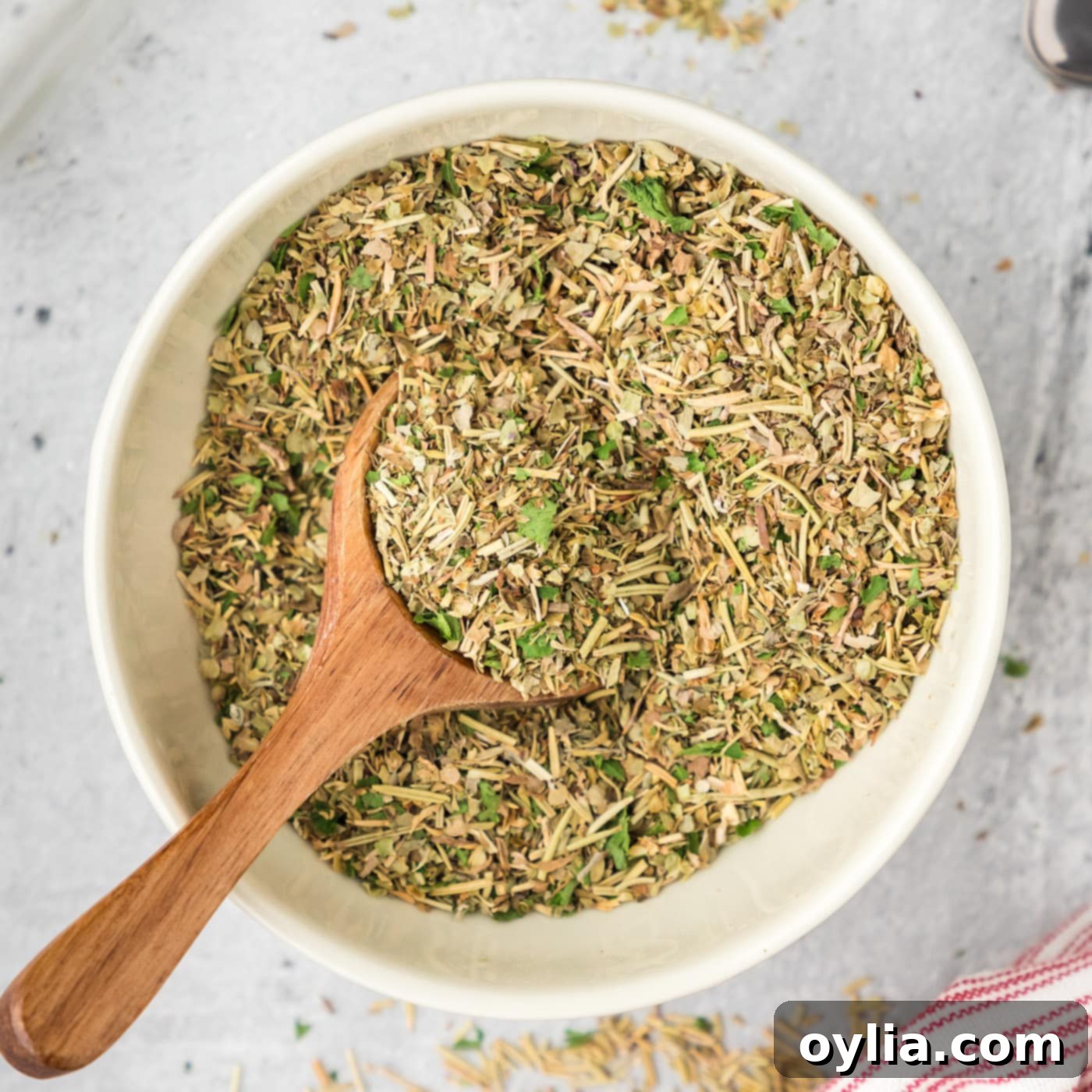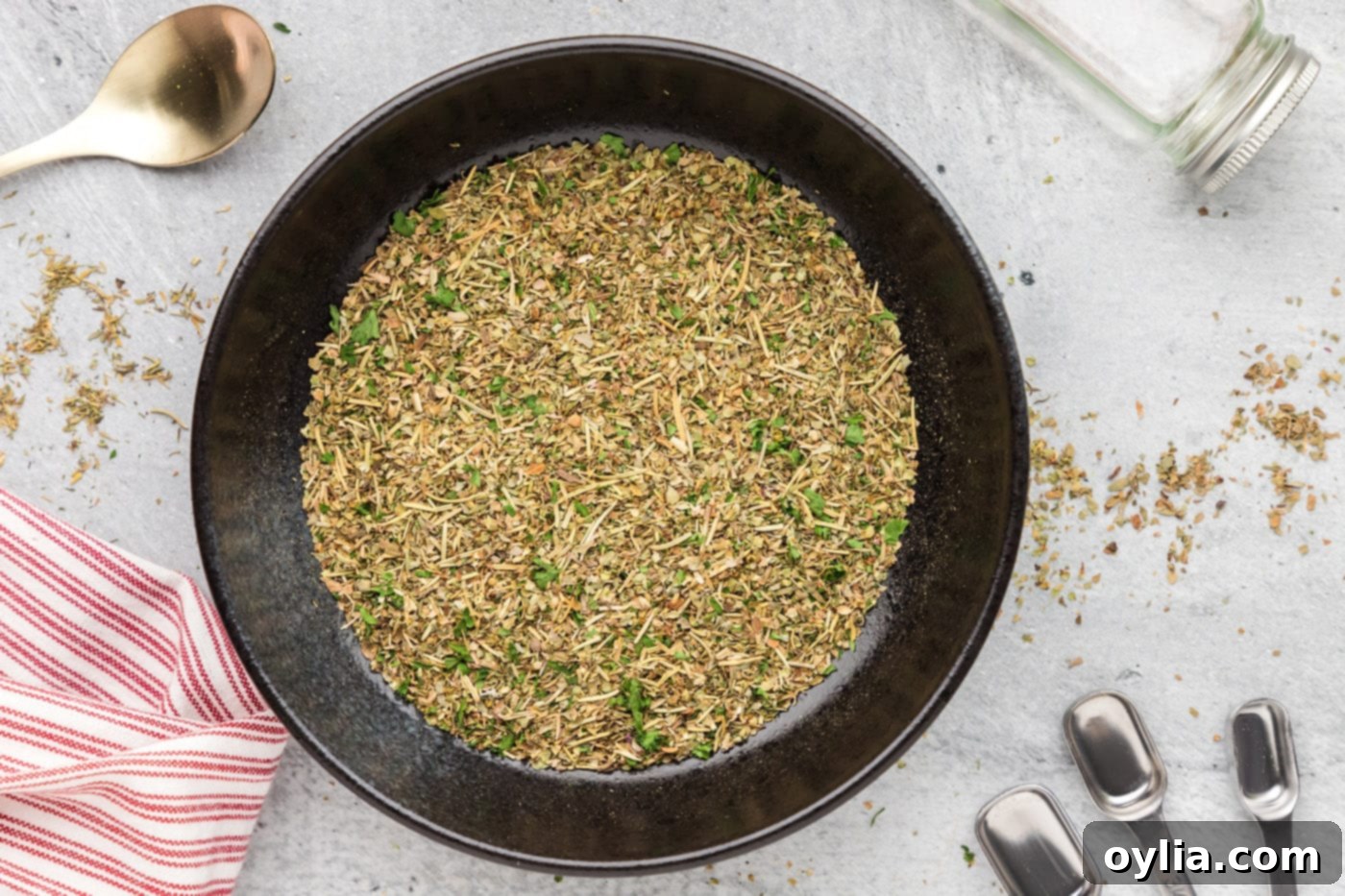Master Your Kitchen: The Ultimate Guide to Homemade Italian Seasoning
Elevate your cooking with a blend that defines the heart of Italian cuisine. This quick and easy recipe for homemade Italian seasoning brings together a symphony of aromatic dried herbs, creating a versatile staple for every savory dish. Say goodbye to store-bought blends and discover the unparalleled freshness and customizable flavor of your own homemade spice mix.
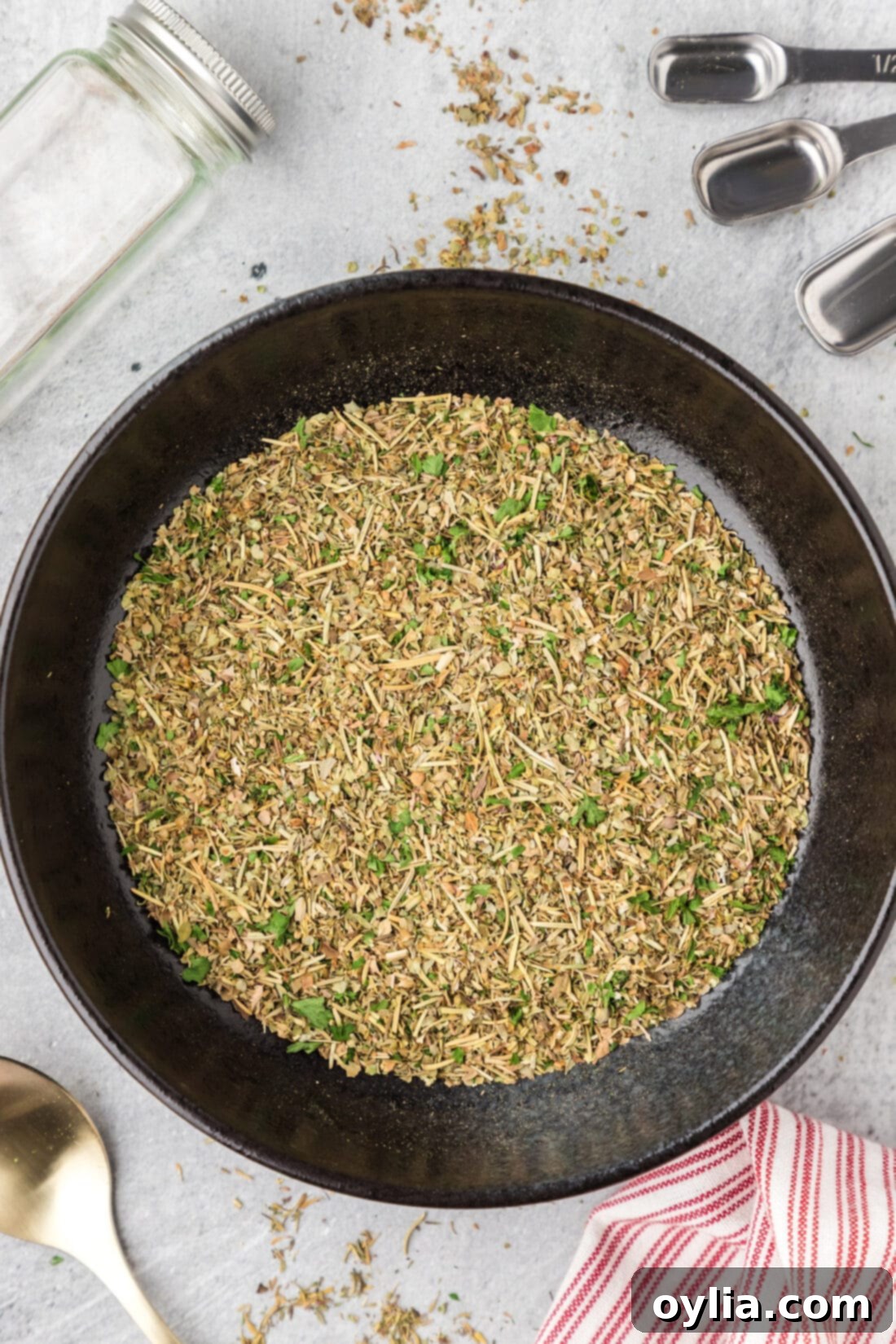
Why Homemade Italian Seasoning is a Must-Have
Italian seasoning is an indispensable blend, typically featuring dried oregano, basil, thyme, rosemary, marjoram, and parsley. This harmonious combination infuses an earthy, herbaceous depth into a vast array of savory dishes. While commercial options are readily available, crafting your own spice blends from scratch offers numerous advantages that truly elevate your culinary experience.
One of the primary benefits of making homemade Italian seasoning is the complete control you gain over the ingredients. This means no hidden fillers, anti-caking agents, or excessive sodium often found in store-bought versions. You know exactly what goes into your blend, ensuring purity and tailoring it precisely to your taste preferences. Furthermore, it significantly reduces the amount of measuring required when cooking, streamlining your prep time in the kitchen.
A generous dash of this versatile Italian herb mix can transform simple ingredients into extraordinary meals. It’s perfect for seasoning bread, enriching hearty lasagna, adding depth to meats, vibrant vegetables, rich sauces, and so much more. This blend is truly the all-purpose workhorse of the dried herb world, designed to complement an incredibly wide variety of dishes, making it an essential component of any well-stocked pantry.
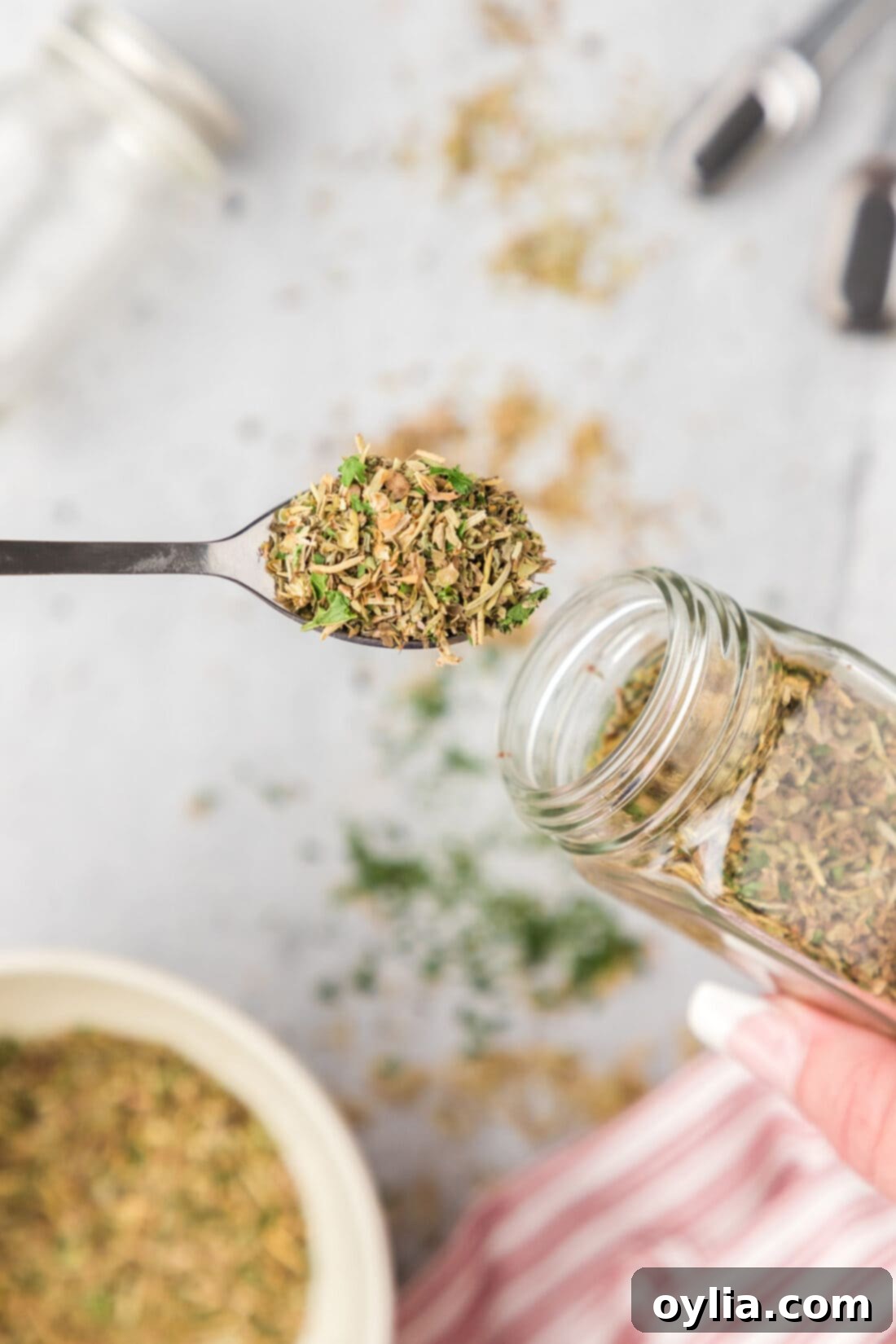
The Essential Herbs in Italian Seasoning: A Flavor Profile Deep Dive
The magic of Italian seasoning lies in the careful balance of its core dried herbs. Each component brings its own distinct character, contributing to the rich, complex flavor profile that makes this blend so universally loved. Understanding these individual notes allows you to appreciate the symphony they create together and even customize your blend further.
- Dried Oregano: Often considered the cornerstone of Italian flavor, oregano provides a pungent, slightly bitter, and peppery taste. It’s robust and earthy, lending a quintessential Mediterranean aroma that is instantly recognizable in pasta sauces and pizzas.
- Dried Basil: Sweet and aromatic, basil offers a slightly peppery and minty flavor with notes of anise. It’s softer than oregano but equally important, providing a fresh, herbaceous sweetness that balances the more intense flavors in the blend.
- Dried Thyme Leaves: Thyme contributes an earthy, minty, and slightly lemony flavor. Its delicate, woody notes add a subtle complexity, pairing wonderfully with roasted vegetables and meats.
- Dried Rosemary: Pungent and piney with hints of lemon and pepper, rosemary is a strong herb that adds a bold, aromatic quality. It’s particularly fantastic with roasted potatoes, lamb, and chicken, giving the seasoning a hearty, rustic touch.
- Dried Marjoram: Closely related to oregano but milder and sweeter, marjoram offers a delicate, floral, and slightly woody flavor. It softens the blend, adding a nuanced sweetness that prevents it from becoming too overpowering.
- Dried Parsley: With its fresh, green, and slightly peppery taste, parsley adds a bright, clean note to the seasoning. While often used as a garnish, its dried form contributes a subtle, fresh lift to the overall blend.
Together, these dried herbs create a balanced and deeply flavorful mix that is incredibly versatile. It’s this combination that makes Italian seasoning such a pantry powerhouse, capable of enhancing countless dishes with its warm, inviting essence.
Ingredients You Will Need for Your Perfect Blend
Crafting your own batch of this essential homemade Italian seasoning requires just a few simple, high-quality dried herbs. The exact measurements for this recipe, along with comprehensive instructions, are conveniently available in the printable version at the end of this post. However, let’s dive a little deeper into the ingredients and potential modifications.
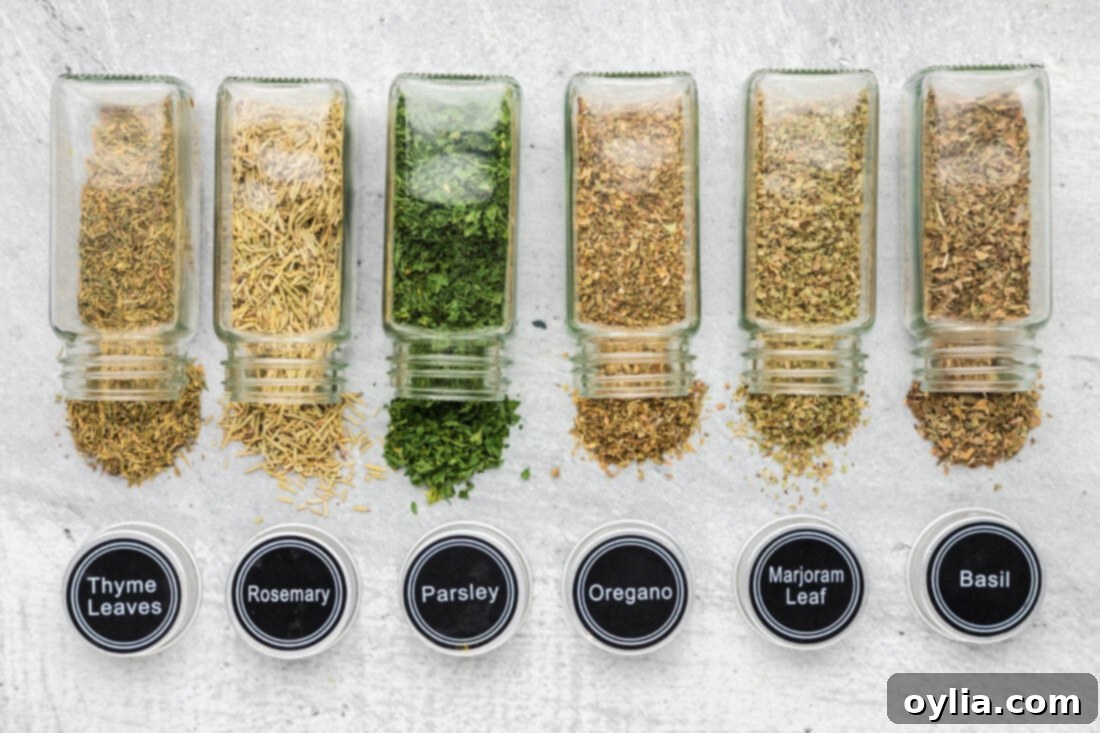
Ingredient Info and Substitution Suggestions
HERBS – The foundation of any authentic Italian seasoning recipe is its rich collection of dried herbs. Our classic blend prominently features dried oregano, basil, thyme leaves, rosemary, marjoram, and parsley. It’s crucial to opt for dried herbs over fresh for this particular blend, as dried herbs possess a more concentrated flavor profile and are essential for extending the shelf life of your homemade seasoning. Using fresh herbs would introduce moisture, drastically shortening the blend’s longevity and requiring refrigeration.
While the classic blend is perfect as is, you are absolutely encouraged to customize it! Many home cooks enjoy adding other complementary seasonings they frequently use. Popular additions include:
- Garlic Powder: For an aromatic kick.
- Onion Powder: To add another layer of savory depth.
- Red Pepper Flakes: If you enjoy a touch of heat, a teaspoon or two can elevate the blend for spicier dishes like spicy bolognese or arrabiata sauce.
- Celery Seed: For a subtle, earthy, and slightly bitter note.
- Ground Bay Leaf: A tiny pinch can add a unique, herbaceous depth.
Remember, the beauty of homemade spice blends is the freedom to adjust them to suit your personal palate. Feel free to experiment with quantities, adding a little more of your favorite herb or a dash of something new to make this Italian seasoning truly your own.
How to Make Your Own Italian Seasoning Blend
These step-by-step photos and instructions are here to help you visualize how to make this recipe. You can Jump to Recipe to get the printable version of this recipe, complete with measurements and instructions at the bottom.
Creating your own homemade Italian seasoning is incredibly straightforward, requiring minimal effort for maximum flavor payoff. The process is so simple, you’ll wonder why you ever bought it pre-made!
- Combine All Ingredients: In a clean, dry mixing bowl, measure out all of your dried herbs according to the recipe card. Ensure your measuring spoons are also dry. Gently combine all the ingredients thoroughly. You can use a whisk, a fork, or even just your hands to ensure an even distribution of each herb throughout the blend. This step is crucial for achieving a consistent flavor in every pinch of seasoning.


- Store for Longevity: Once thoroughly mixed, transfer your fresh homemade Italian seasoning blend into an airtight container. A spice jar is ideal, as it protects the herbs from air and moisture, preserving their potency. Stored correctly, this vibrant blend will maintain its peak flavor for up to 12 months, though it can last longer (see FAQ for more details).
Frequently Asked Questions & Expert Tips for Your Italian Seasoning
Homemade Italian seasoning made with dried herbs can be stored in an air-tight glass jar kept in a cool, dark place for 1-2 years. Heat, light, and air are the enemies of dried herbs and spices, causing them to lose their flavor and potency more quickly. Therefore, a dark cabinet or pantry, away from the stove or direct sunlight, is ideal. Once the blend is no longer fragrant – meaning you can’t readily smell the individual herbs when you open the jar – its shelf life has reached its limit and it’s time to make a fresh batch. Glass is preferable over plastic for storing spices as it isn’t porous, preventing any lingering odors or flavors from permeating the container.
While fresh herbs are wonderful for many dishes, they are not suitable for making a shelf-stable Italian seasoning blend. Fresh herbs contain moisture, which would lead to spoilage and mold if stored at room temperature. For a long-lasting dry blend, always use dried herbs. If you’re looking to add fresh Italian flavors to a specific dish, you can always incorporate fresh herbs directly into that recipe alongside your dried seasoning.
For most applications, it is not necessary to grind the dried herbs. The beauty of Italian seasoning is often in the visual variety of the different herbs, and their flavors will release perfectly well as is. However, if you prefer a finer texture, particularly for rubs or smooth sauces, you can lightly pulse the combined herbs in a spice grinder or a clean coffee grinder for a few seconds. Be careful not to over-process, as this can turn them into a fine powder and release their oils too quickly, reducing shelf life.
While the recipe provides a classic combination, you can certainly adapt it based on what you have on hand. The most critical herbs are oregano and basil. If you’re missing one or two of the others (thyme, rosemary, marjoram, parsley), your blend will still be delicious. You might adjust the proportions of the remaining herbs slightly to compensate. For example, if you don’t have marjoram, a little extra oregano or basil could work. Experiment and find your perfect balance!
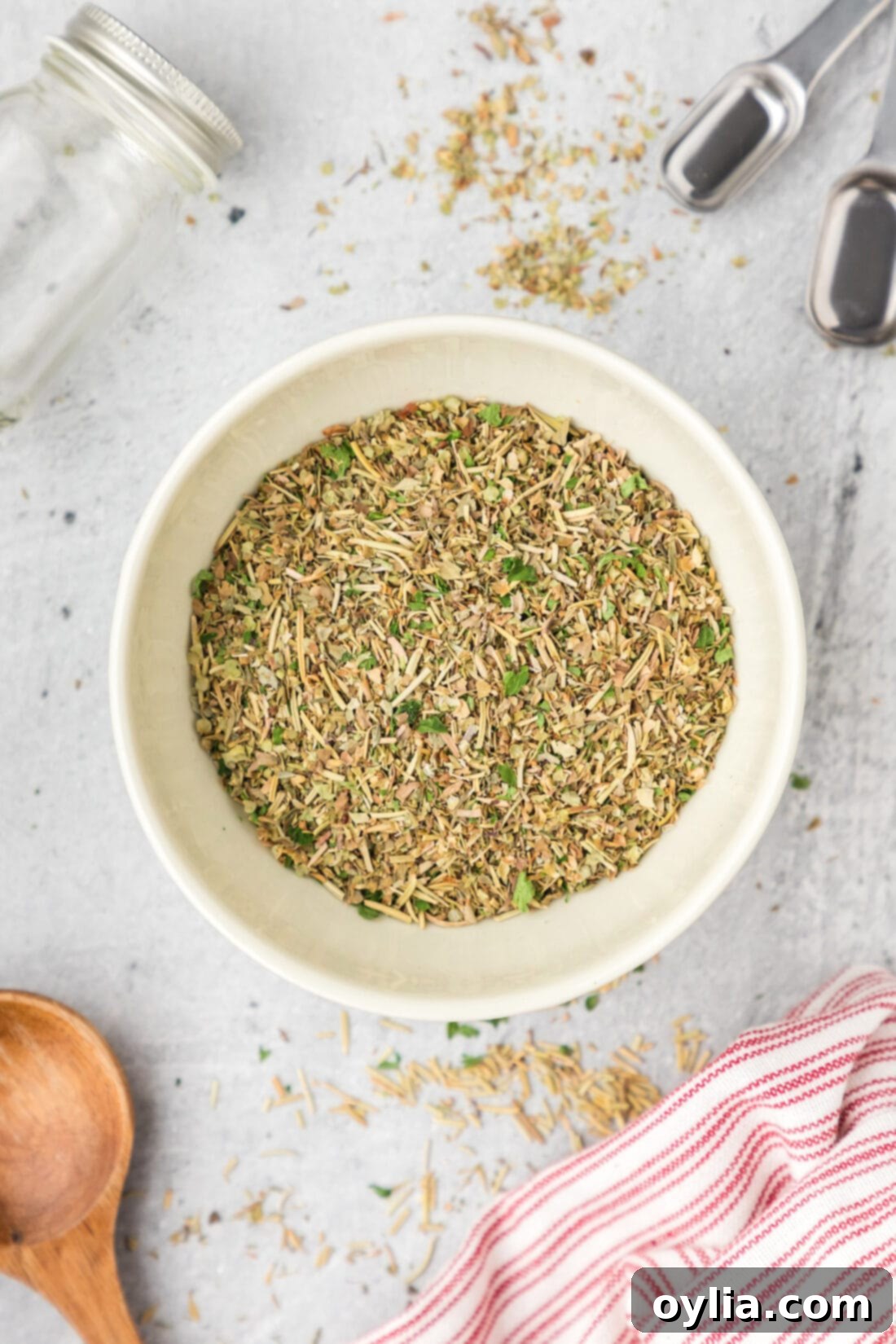
Serving Suggestions: Unleash the Flavor in Every Dish
The beauty of homemade Italian seasoning lies in its boundless versatility. This flavorful blend knows no limits and can enhance almost any savory dish you can imagine. Here are just a few ideas to get your culinary creativity flowing:
- Meats & Poultry: Sprinkle generously over grilled, baked, or seared chicken, pork, beef, or fish. It makes an excellent dry rub or can be incorporated into marinades for a tender, flavor-packed result. Try it with roasted chicken or a simple pan-seared steak.
- Vegetables: Toss with your favorite vegetables before roasting, grilling, or sautéing. Broccoli, zucchini, bell peppers, asparagus, and potatoes all come alive with a dusting of Italian seasoning and a drizzle of olive oil.
- Pasta & Sauces: This is where Italian seasoning truly shines! Stir it into classic Italian dishes such as spaghetti sauce, hearty lasagna, rich bolognese, or simple marinara. It’s also fantastic in your homemade pizza sauce or sprinkled over a fresh pasta salad.
- Bread & Appetizers: Mix it with softened butter and baste it over garlic bread or bruschetta for an irresistible appetizer. Sprinkle it over focaccia dough before baking, or blend it into olive oil for a simple, flavorful dipping sauce for crusty bread.
- Soups & Stews: Add a teaspoon or two to your favorite minestrone, vegetable soup, or a slow-cooked beef stew to deepen the flavor profile. It melts beautifully into broths and stocks, infusing them with aromatic goodness.
- Salad Dressings: Whisk a pinch into your homemade vinaigrettes for a Mediterranean twist. It pairs exceptionally well with a lemon-herb dressing.
- Eggs & Breakfast: Don’t limit it to dinner! A sprinkle of Italian seasoning can perk up scrambled eggs, omelets, or even a savory breakfast frittata.
- Popcorn & Snacks: For an unexpected savory treat, sprinkle some Italian seasoning over freshly popped popcorn with a little Parmesan cheese.
With this easy homemade Italian seasoning recipe, you’ll always have a secret weapon in your pantry to add a burst of authentic Italian flavor to virtually any meal.
Discover More Homemade Seasoning Recipes
Once you experience the freshness and control of making your own Italian seasoning, you’ll be hooked! Expand your spice rack with these other fantastic homemade seasoning blends:
- Chili Seasoning
- Taco Seasoning
- Cajun Seasoning
- Shrimp Seasoning
- All Purpose Seasoning
I love to bake and cook and share my kitchen experience with all of you! Remembering to come back each day can be tough, that’s why I offer a convenient newsletter every time a new recipe posts. Simply subscribe and start receiving your free daily recipes!
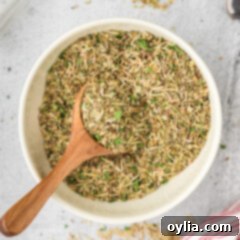
Italian Seasoning
IMPORTANT – There are often Frequently Asked Questions within the blog post that you may find helpful. Simply scroll back up to read them!
Print It
Pin It
Rate It
Save ItSaved!
Ingredients
- 2 Tablespoons dried oregano
- 2 Tablespoons dried basil
- 2 Tablespoons dried thyme leaves
- 2 Tablespoons dried rosemary
- 2 Tablespoons dried marjoram
- 1 Tablespoon dried parsley
Things You’ll Need
-
Mixing bowl
-
Measuring spoons
-
Spice jar or other air-tight container with a lid
Before You Begin
- It’s important to use dried herbs as opposed to fresh to extend the shelf life and get the most out of your blend. You’re always welcome to throw in any other seasonings you find yourself reaching for often such as garlic powder or onion powder.
Instructions
-
Combine all ingredients thoroughly in a mixing bowl.
-
Store in an airtight container for 12 months.
Expert Tips & FAQs
- Dried herbs can last for up to 2 years. To get the longest life from your herbs, keep them in an airtight container at room temperature and away from direct sunlight. A dark cabinet or pantry is best. Once the blend is no longer fragrant, its shelf time has reached its limit. Glass is preferable over plastic for storing spices and seasonings as it isn’t porous.
Nutrition
The recipes on this blog are tested with a conventional gas oven and gas stovetop. It’s important to note that some ovens, especially as they age, can cook and bake inconsistently. Using an inexpensive oven thermometer can assure you that your oven is truly heating to the proper temperature. If you use a toaster oven or countertop oven, please keep in mind that they may not distribute heat the same as a conventional full sized oven and you may need to adjust your cooking/baking times. In the case of recipes made with a pressure cooker, air fryer, slow cooker, or other appliance, a link to the appliances we use is listed within each respective recipe. For baking recipes where measurements are given by weight, please note that results may not be the same if cups are used instead, and we can’t guarantee success with that method.
